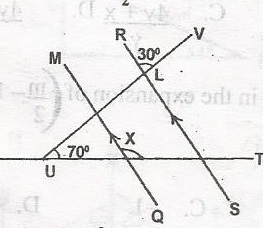
In the diagram, MQ//RS, < TUV = 70o and < RLV = 30o. Find the value of x
150o
110o
100o
95o
Correct answer is C
L + 30o - 180o(Sum of < s on straight line)
L = 180o - 30o = 150o
L = q = 150o(opposite < s are equal)
y = b = 30o(alt. < s)
b + c = 180o(sum of < s on str. line)
30o + c 180
c = 180 - 30
c = 150o
b = a = 30o (opp < s are equal)
c = d = 150o (opp < s are equal)
a + k + 70o = 180o (sum of < s on △)
30o + k + 70o = 180
k + 100o = 180
k = 180 - 100
k = 80o
x + 80o = 180(sum of < s on straight line)
x = 180o - 80o
x = 100o
Similar Questions
In the diagram, HK is parallel to QR, PH = 4cm and HQ = 3cm. What is the ratio of KR:PR? ...
Find the determinant of the matrix A = \(\begin{pmatrix} 2 & 3 \\ 1 & 3&...
Three exterior angles of a polygon are 30o, 40o and 60o. If the remaining exterior an...
Factorise (4a + 3) 2 - (3a - 2)2...
If tan x = 225, find the value of sin x; 0 ≤ x ≤ 90o...
Simplify 0.000215 x 0.000028 and express your answer in standard form ...
In the diagram above. |AB| = 12cm, |AE| = 8cm, |DCl = 9cm and AB||DC. Calculate |EC| ...